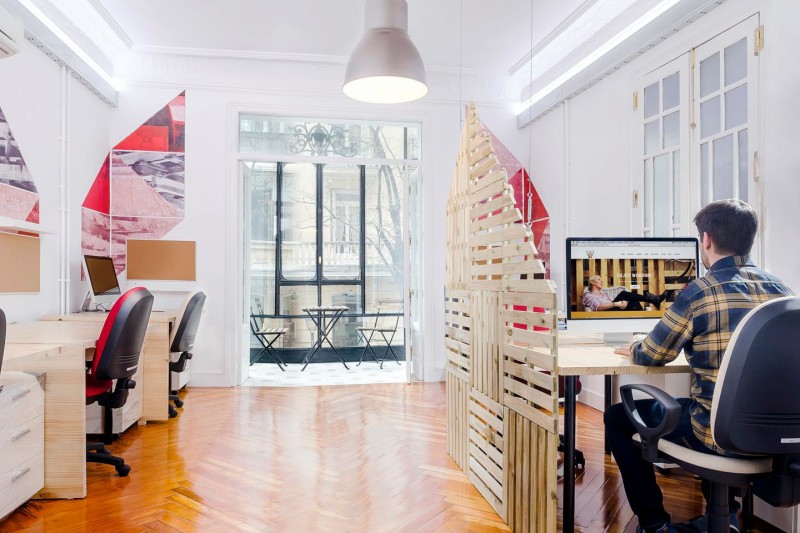Best Coworking Spaces in Madrid
Madrid is becoming increasingly friendly toward freelancers and startups, thanks to its great coworking spaces and work-friendly cafés. Here’s a list of our favorites, located in different central neighborhoods of the city. Although each one has something unique to offer, they have the essentials in common: fast WiFi and plenty of coffee.
Espíritu 23

Image from Espíritu 23
- Website, Facebook & Instagram @espiritu_23
- Address: Calle del Espíritu Santo 23
- Metro: Tribunal/Noviciado
Situated in the heart of Malasaña, this coworking space definitely reflects the nature of the neighborhood. There’s also a friendly café open to the public. It has a young, artsy and urban vibe, with lots of personality. Of course the coworking space offers a fast internet connection, a kitchen, a meeting room, events, activities, workshops… the works. Best of all, the fees are great and the location couldn’t be better.
Plázida – Loom

Image from Plázida
- Plázida: Website, Facebook & Instagrram @plazidacowork
- Loom: Website
- Address: Calle Vandergoten, 1 and Calle de la Princesa, 5
- Metro: Atocha and Plaza de España
Plázida prides itself on being specifically designed for digital nomads. It collaborates with LoomHouse in two Madrid locations; one is near Atocha train station, occupying the former building of the Royal Tapestry Factory, with a beautiful outdoor garden area. The other is centrally located right by Plaza de España, complete with a rooftop hangout space. At both locations you’ll find high ceilings, brick walls, bright light, ergonomic workstations, and more. There are several member options to choose from for both individuals and teams, ranging from half days to 24/7 access.
Google Campus

- Website
- Address: Calle Moreno Nieto, 2
- Metro: La Latina or Puerta del Ángel (it’s a bit of a walk from the metro)
Google campus isn’t exactly a coworking space, but more like a giant café that anyone is welcome to work at, for free! There are several tables spread out across two floors, outlets everywhere and fast internet connection. Plus there are events held regularly and good food options at the café operated by Do Eat. The building also has offices for startups in the upper levels, and a huge conference room. All in all, it’s a great environment for working, networking, having a lunch meeting, or setting up your own individual office.
The Shed Coworking

Image from The Shed
- Website, Facebook, and Instagram @theshedcoworking
- Address: 48, 1Dch Calle de Hermosilla, Madrid, Spain
- Metro: Velázquez
Located in Madrid’s Salamanca district, The Shed is one of the city’s top coworking spaces thanks to its positive work environment, community of creative professionals, and helpful staff. You’ll find tons of natural light, plenty of workspace options, and an outdoor terrace. Members have lots of benefits, from access to the meeting rooms and kitchen to ergonomic chairs and free coffee. Workshops are also held periodically in the communal training room.
La Piscine

Image from La Piscine
La Piscine calls itself a “workplace for everybody.” It’s essentially a cute coffee shop where you pay by the hour to use the WiFi and get unlimited coffee, tea, and snacks. It also holds workshops and events. Located in the trendy and modern neighborhood of Chueca, it’s a great environment to work in. What’s most convenient is that you don’t have to commit to a month-long membership; you can just set up shop for a few hours and enjoy bottomless cups of coffee while you work away on your laptop. Packs of hours are available at discounted rates, if you become a regular.
Impact Hub Madrid

Image from Impact Hub Madrid
- Website, Facebook and Instagram @impacthubmad
- Address: 5 locations (original in Barrio de las Letras)
No article about Madrid’s top coworking spaces would be complete without mentioning Impact Hub, which has been actively supporting the city’s international innovators and entrepreneurs for years. Now with five giant locations around Madrid, it not only provides an ideal work space for freelancers and startups alike, but also a truly impressive calendar full of information sessions, workshops, initiatives, events, markets and more.
La Industrial

Image from La Industrial
This 400-square-meter space is located in the heart of Malasaña. It’s open to all types of professionals and offers a number of affordable member options, from daily to monthly passes (you can try out a day for free). You can rent out a spot at the open area, private workstations, meeting rooms and different spaces for workshops, events, markets, you name it. They have an additional 250-square-meter events space on Calle San Ferrer 33. Plus it’s pet-friendly!
Utopic_US

- Website, Facebook and Instagram @utopic_us
- Address: 5 locations, original on Calle Colegiata and Duque de Rivas (across the street)
Utopic_US has the benefit of being one of the city’s most established coworking spaces. Although it now has a number of locations, the most famous ones are on Calle Colegiata and Duque de Rivas, just across the street from each other, between Tirso de Molina and La Latina. Utopic_US offers private offices, meeting rooms, and open works areas for small businesses, startups, and freelancers. Members have access to a wide range of networking events and workshops, yoga and mindfulness classes… There’s also a full café and restaurant that’s open to the public.
Bee Lab

Image from Bee Lab
This bright and friendly coworking space is fully equipped with everything a small business owner, startup, or freelancer could possibly ask for: both private and shared work areas, meeting rooms, a kitchen, a fast internet connection, a chill-out room, an outdoor terrace, and even a mini golf course. And it’s pet friendly too! You’ll be sharing your work space with people from around the world and there are a number of networking opportunities, such as Friday breakfasts.





























































